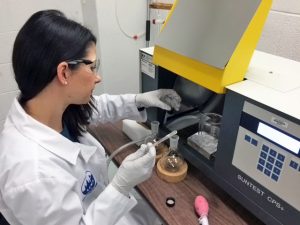Study Finds Sunlight Enhances Water Solubility of Oil
– February 10, 2015
Scientists from the University of New Orleans and Florida State University conducted simulated sunlight exposure experiments to determine sunlight’s effects on oil fate.
They found that solar energy generated chemical reactions in oil molecules that resulted in increased oxidation, changing the oil’s chemical structure and promoting the mixing of oil and water. Once oxidized, multiple oxygen-rich photochemical pathways developed, making petroleum compounds susceptible to further oxidation. The scientists published their findings in the September 2014 edition of the Journal of Hazardous Materials: Sunlight creates oxygenated species in water-soluble fractions of Deepwater Horizon oil.
To better understand the biological and environmental implications of oil spills, it is important to understand how oil-sunlight interactions affect oil behavior and fate. Previous studies have established that oxygen-rich compounds form during the weathering process, but their results did not differentiate between biodegradation and photodegradation and did not analyze the transformations at the molecular level. This study’s team conducted controlled laboratory experiments that examined water and Macondo oil mixtures under conditions with and without simulated sunlight. They observed the oil’s molecular changes using Fourier transform ion cyclotron resonance mass spectrometry combined with electrospray ionization.
There was a nearly two-fold increase in water-soluble organic elements in oil-water mixtures exposed to simulated sunlight than in mixtures kept in the dark, with oxygen being the most abundant element. The team observed that sunlight-exposed mixtures were dominated by molecules containing higher-order oxygen classes, with 5 oxygen atoms being most abundant (in a 1-10 range). Mixtures not exposed to sunlight had molecules containing lower-order oxygen classes, with 2 oxygen atoms being most abundant. The prevalence of higher-order oxygen classes in sun-exposed oil compounds indicates that sunlight may accelerate oil degradation by increasing its ability to dissolve in water.
The researchers also observed a pattern in compositional changes – as oxygen increased in sunlight-exposed mixtures, so did carbon. The higher-order oxygen classes correlated to higher-order carbon classes, and to higher numbers of double bonds to carbon. These results suggest that the initial oxidation of oil compounds makes them capable of attracting additional oxygen, which increases oxidation susceptibility and enhances degradation processes.
This study is the first to report molecular-level chemical measurements of oil photo-transformation. Phoebe Ray and Matthew Tarr, two of the study’s authors, offered some insight into how these findings can be applied to oil spill research, “Just like humans, oil can get a sunburn. The photo-oxidation process can help clean up oil spills, but it can also create toxic products. The molecules formed can then be exposed to microorganisms to help us learn how this process affects the ecosystem after an oil spill.”
The study’s authors are Phoebe Z. Ray, Huan Chen, David C. Podgorski, Amy M. McKenna, and Matthew A. Tarr.
************
This research was made possible in part by a grant from the Gulf of Mexico Research Initiative (GoMRI) to the University of New Orleans Department of Chemistry for their project Effect of Photochemistry on Biotransformation of Crude Oil. Other funding sources included the National Science Foundation Division of Materials Research (DMR-11-57490) and Division of Chemistry (CHE-1111525), the Florida State University Future Fuels Institute, and the State of Florida.
The Gulf of Mexico Research Initiative (GoMRI) is a 10-year independent research program established to study the effect, and the potential associated impact, of hydrocarbon releases on the environment and public health, as well as to develop improved spill mitigation, oil detection, characterization and remediation technologies. An independent and academic 20-member Research Board makes the funding and research direction decisions to ensure the intellectual quality, effectiveness and academic independence of the GoMRI research. All research data, findings and publications will be made publicly available. The program was established through a $500 million financial commitment from BP. For more information, visit https://gulfresearchinitiative.org/.
© Copyright 2010- 2017 Gulf of Mexico Research Initiative (GoMRI) – All Rights Reserved. Redistribution is encouraged with acknowledgement to the Gulf of Mexico Research Initiative (GoMRI). Please credit images and/or videos as done in each article. Questions? Contact web-content editor Nilde “Maggie” Dannreuther, Northern Gulf Institute, Mississippi State University (maggied@ngi.msstate.edu).






